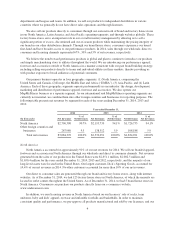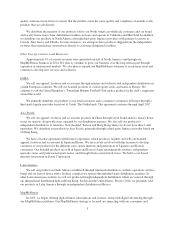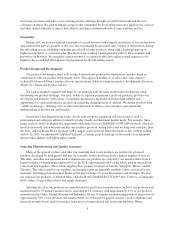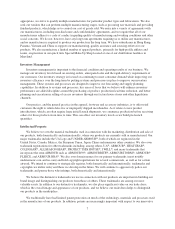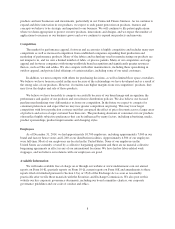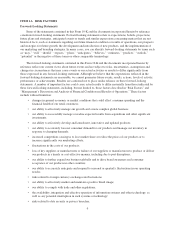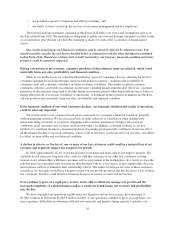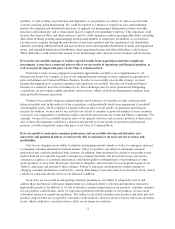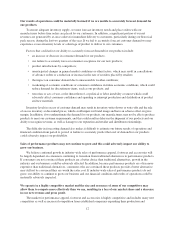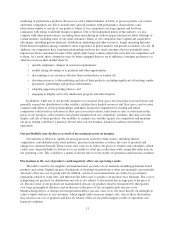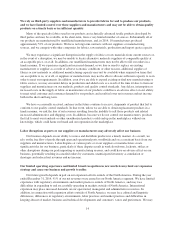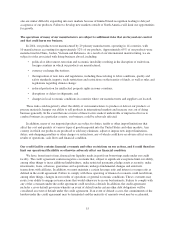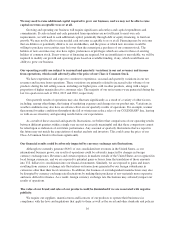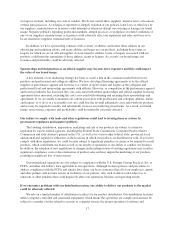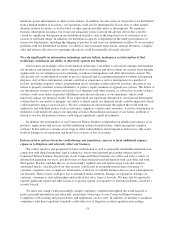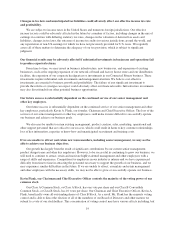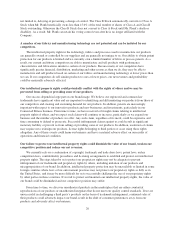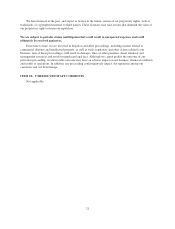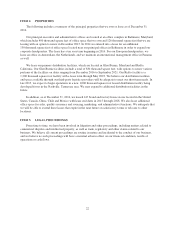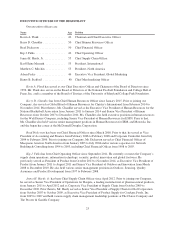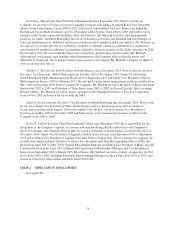Under Armour 2014 Annual Report Download - page 24
Download and view the complete annual report
Please find page 24 of the 2014 Under Armour annual report below. You can navigate through the pages in the report by either clicking on the pages listed below, or by using the keyword search tool below to find specific information within the annual report.We rel
y
on th
i
rd-
p
art
y
su
pp
l
i
ers and manu
f
acturers to
p
rov
i
de
f
abr
i
cs
f
or and to
p
roduce our
p
roducts
,
and we have l
i
m
i
ted control over these su
pp
l
i
ers and manu
f
acturers and ma
y
not be able to obta
i
n
q
ual
i
t
y
p
roducts on a t
i
mel
y
bas
i
sor
i
nsu
ffi
c
i
ent
q
uant
i
t
y
.
M
any of the specialty fabrics used in our products are technically advanced textile products developed by
third parties and may be available, in the short-term, from a very limited number of sources. Substantially all of
o
ur products are manufactured by unaffiliated manufacturers, and, in 2014, 10 manufacturers produce
d
approximately
5
2% of our products. We have no long term contracts with our suppliers or manufacturin
g
sources, and we compete with other companies for fabrics, raw materials, production and import quota capacity.
We may experience a significant disruption in the supply of fabrics or raw materials from current sources or,
in the event of a disruption, we may be unable to locate alternative materials suppliers of comparable quality at
an acceptable price, or at all. In addition, our unaffiliated manufacturers may not be able to fill our orders in a
timely manner. If we experience significant increased demand, or we lose or need to replace an existing
manufacturer or su
pp
lier as a result of adverse economic conditions or other reasons, additional su
pp
lies o
f
f
abrics or raw materials or additional manufacturing capacity may not be available when required on terms tha
t
are acceptable to us, or at all, or suppliers or manufacturers may not be able to allocate sufficient capacity to us in
o
rder to meet our requirements. In addition, even if we are able to expand existing or find new manufacturing o
r
f
abric sources, we may encounter delays in production and added costs as a result of the time it takes to train our
suppliers and manufacturers on our methods, products and quality control standards. Any delays, interruption or
increased costs in the supply of fabric or manufacture of our products could have an adverse effect on our abilit
y
to meet retail customer and consumer demand for our
p
roducts and result in lower net revenues and net incom
e
both in the short and long term
.
We have occasionally received, and may in the future continue to receive, shipments of product that fail t
o
conform to our quality control standards. In that event, unless we are able to obtain replacement products in
a
timely manner, we risk the loss of net revenues resulting from the inability to sell those products and related
increased administrative and shipping costs. In addition, because we do not control our manufacturers, products
that fail to meet our standards or other unauthorized
p
roducts could end u
p
in the market
p
lace without our
knowledge, which could harm our brand and our reputation in the marketplace.
Labor d
i
sru
p
t
i
ons at
p
orts or our su
pp
l
i
ers or manu
f
acturers ma
y
adversel
y
a
ff
ect our bus
i
ness.
Our business depends on our ability to source and distribute products in a timely manner. As a result, w
e
r
ely on the free flow of goods through open and operational ports worldwide and on a consistent basis from our
su
pp
liers and manufacturers. Labor dis
p
utes at various
p
orts or at our su
pp
liers or manufacturers creat
e
significant risks for our business, particularly if these disputes result in work slowdowns, lockouts, strikes or
o
ther disruptions during our peak importing or manufacturing seasons, and could have an adverse effect on ou
r
business, potentially resulting in canceled orders by customers, unanticipated inventory accumulation or
shortages and reduced net revenues and net income.
O
ur l
i
m
i
ted operat
i
ng exper
i
ence and l
i
m
i
ted brand recogn
i
t
i
on
i
n new markets may l
i
m
i
t our expans
i
on
strategy and cause our bus
i
ness and growth to su
ff
er.
Our future growth depends in part on our expansion efforts outside of the North America. During the year
ended December 31, 2014, 91% of our net revenues were earned in our North America segment. We have limited
experience with regulatory environments and market practices outside of North America, and may face
difficulties in expanding to and successfully operating in markets outside of North America. International
expansion may place increased demands on our operational, managerial and administrative resources. In
addition, in connection with expansion efforts outside of North America, we may face cultural and linguistic
differences, differences in regulatory environments, labor practices and market practices and difficulties i
n
keeping abreast of market, business and technical developments and customers’ tastes and preferences. We may
14


